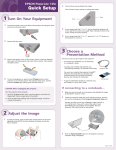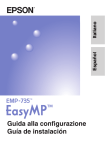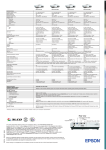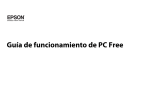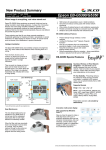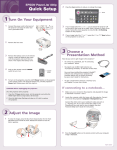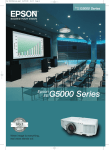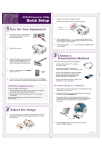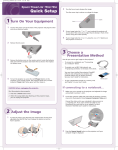Download Epson 735c Start Here Card
Transcript
EPSON PowerLite 735c ® ® Quick Setup 2 3 Rotate the focus ring to sharpen the image. Press the Comp/EasyMP button on the remote control until your computer image is displayed. Rotate the zoom ring to reduce or enlarge the image. Page down Page up Comp/EasyMP S-Video/Video Color Mode 1 Turn On the Projector 1 Comp/EasyMP button Focus ring Zoom ring Keystone button Connect the power cord to the back of the projector and plug the other end into a grounded outlet. 3 4 If your image looks like or , press the Keystone button on the projector. or If you’re using a laptop and you see a blank screen, you may need to adjust its display settings: Windows®: Hold down the Fn button on the keyboard and press the function key that lets you display on an external monitor. It may have an icon such as , or it may be labeled CRT/LCD. You may have to use the Display utility in the Control Panel to enable both the LCD screen and the external monitor port. If your image looks like or , you’ve placed the projector off to one side of the screen at an angle. Place it directly in front of the center of the screen, facing the screen squarely. 4 2 Power Macintosh® OS 9 or earlier: From the Apple menu, select Control Panels, then click Monitors or Monitors and Sound. Click the Arrange icon, then drag one monitor icon on top of the other; this lets you display on both the projection screen and the LCD screen. If this option isn’t available, click the Monitor icon and select a Simulscan resolution. side of the Remove the lens cover. Click here 3 Choose a Presentation Method Drag one monitor icon onto the other How do you want to get images to the projector? 3 Locate the projector’s remote control. Before using it for the first time, pull out the plastic tape from the battery tray (you don’t have to open the tray). To connect computer or video equipment, see the instructions below and on the right. Macintosh OS X: From the Apple menu, select System Preferences, then click Displays. Select the VGA Display or Color LCD dialog box, click the Arrange (or Arrangement) tab, and make sure Mirror Displays is checked. 5 To project over an 802.11b network, see “If projecting wirelessly” on the back of this sheet. 4 Aim the remote control at the projector and press the red Power button. The Power light flashes green and the projector lamp comes on in about 40 seconds. Page down Page up Power Power button Comp/EasyMP S-Video/Video Color Mode Menu A/V Mute To give a presentation stored on a memory card, see Chapter 5 in your User’s Guide. Freeze E-Zoom Enter Auto 2 1 If you see an image but it’s not displayed correctly, press the Auto button on the remote control to automatically readjust it. If connecting video equipment... 1 Make sure you’ve turned on the projector and adjusted the image as described on the far-left. 2 Locate the RCA-style video cable that came with the projector. Connect one end to the projector’s Video port. 3 Connect the other end to the video-output connector on your video equipment. 4 Press the S-Video / Video button on the remote control until your video image is displayed. For details on any of these topics, see your User’s Guide. ESC If connecting a computer... Adjust the Image To raise the image, press the blue foot release buttons on each side of the projector and lift the front. Release the buttons to lock the feet in position. 1 Make sure you’ve turned on the projector and adjusted the image as described at left. 2 Locate the VGA cable that came with the projector. Connect one end to the projector’s Computer/Component Video port. Connect the other end to your laptop’s video-out port. (If you’re using a desktop model, first disconnect the monitor cable from the computer, then plug in the projector cable.) You can fine-tune the height by rotating the feet. Page down Page up Power Comp/EasyMP S-Video/Video Color Mode S-Video/Video button continued continued Configure the projector If projecting wirelessly... Follow the steps in this section to project over an 802.11b wireless network. 1 NOTE: These instructions tell you how to connect a single computer to the projector using Ad Hoc mode. To connect multiple computers using Infrastructure mode, see your User’s Guide. On the EasyMP Network Screen, the Config button is already highlighted. To select Config, press the Enter button on the remote control. You see this screen: 2 Right-click the Wireless Network Connection icon and select Properties. You see a screen like this. 3 Click the Configure button. Configure button Easy connect mode Install the software Before installing the projector’s EasyMPTM software, make sure your computer meets these requirements: 4 Click the Advanced tab. You see a screen like this: 5 Check your network card’s device settings. (Depending on the type of card or wireless transmitter you’re using, some of the setting names may be different from those listed here.) • Must be running Windows 98, 2000, Me, or XP (Macintosh not supported) • Must have an 802.11b network card or transmitter already installed (to project over a wireless network) 1 Insert the EasyMP software CD-ROM in your computer’s CD-ROM drive and wait a few seconds for it to be recognized. 2 Make sure Easy connect mode is selected, as shown above. If not, use the arrow buttons on the remote control to highlight the checkbox next to Easy connect mode, then press Enter to select it. 3 Use the arrow buttons on the remote control to highlight Advanced (next to Easy connect mode), then press Enter to select it. You see this screen: You see this screen: • Set the network type to 802.11 Ad Hoc. • Set the SSID to match the name you assigned to the projector’s ESSID—for example, CONF ROOM. (If your network card uses channel mode instead, set the correct channel, 1 to 11, so it matches that of the projector.) • Make sure encryption is Disabled. 2 3 4 5 6 Click the button to advance to the next screen. 4 Make sure the option to install EMP NS Connection is highlighted, then click the button. Follow the instructions on the screen to finish installing it. If you want to be able to monitor the projector remotely from this computer, select the option for EMP Monitor to install it on your system. See your User’s Guide for details. When done installing the software, click the 5 7 When done making these settings, click OK as needed to close any open dialog boxes. Run NS Connection Now you’re ready to launch NS Connection and project wirelessly. 1 From the Start menu, select EMP NS Connection. You see this screen: To enable your computer to find the projector on the network, select the appropriate Ad hoc mode settings: • Select ESSID ad hoc if your computer’s network card supports an SSID or ESSID identifier. Then enter a name (for example, “CONF ROOM”) in the ESSID text box and press Enter. button to exit. Select your projector • Select Channel ad hoc if your network card supports using channels instead of ESSID names to identify devices on the network. Then select a channel number in the Channel text box and press Enter. Start EasyMP 1 Click the General tab to make sure the network card or wireless network device is enabled. Make sure the projector has a unique name, such as PROJ 1, so you can identify it from your computer. If you need to rename it, highlight the Clear button next to Projector name, then press Enter to clear the text box. Then highlight the text box and press Enter. Use the up and down arrows to select individual characters (if you want to insert a blank space, it comes before capital ‘A’); use the right arrow to move to the next character position. When done typing, press Enter. If you want to use your projector’s memory card feature, select the option for EMP SlideMaker2 and install it the same way. For more information on using a memory card, see your User’s Guide. 6 Make sure you’ve turned on the projector and adjusted the image as described in sections 1 and 2 on the front of this sheet. 2 Select EasyMP as the source by pressing the Comp/EasyMP button on the remote control. 3 Insert the EPSON 802.11b card face-up as shown. 6 Configure the computer NOTE: Use only the EPSON 802.11b card. Other brands may not be compatible and are not guaranteed to work. 1 If the connection is working properly, you see your projector listed as shown. When done making these settings, highlight the OK button at the top of the screen (use the arrow buttons on the remote control or press ESC to highlight it), then press Enter. Highlight the OK button again and press Enter to return to the main EasyMP Network Screen. If you don’t see your projector, click Option, then click Switch LAN. Verify that the correct wireless network device is selected. Sometimes another network device, such as an Ethernet card, may be selected instead. If you don’t see your wireless device listed, but you’re sure you’ve enabled it as described in “Configure the computer,” you may need to restart your computer. 2 Access your wireless network Properties window. For example, in Windows XP you would click Start > Control Panel > Network and Internet Connections. Then click the Network Connections icon. You see a screen similar to this: Once the name of your projector appears, select it and click Connect. You see your computer’s image transmitted to the projector, and a floating control bar appears on the screen: Click here to minimize Once the card is inserted, you see a screen like this: Right-click and select Properties Config button 3 If necessary, drag the control bar out of the way, or minimize it by clicking it as shown above. 4 When done with your presentation, click Disconnect on the control bar. EPSON is a registered trademark and EasyMP is a trademark of SEIKO EPSON CORPORATION. PowerLite is a registered trademark of Epson America, Inc. continued General Notice: Other product names are for identification purposes only and may be trademarks of their respective owners. EPSON disclaims any and all rights in those marks. Copyright © 2003 by Epson America, Inc. 1/03 Printed on recycled paper. CPD-15676 Printed in USA



